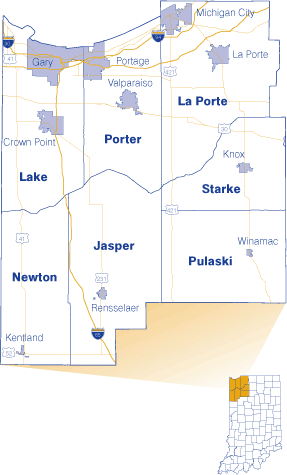Around and 'Round the Mulberry Bush: Intra-Region Employment Commuting in Economic Growth Region 1
Economic Growth Region (EGR) 1 includes Jasper, Lake, La Porte, Newton, Porter, Pulaski and Starke counties, and is home to firms that employ 313,320 Hoosiers (annual average for 2004). It boasts a population of 838,333, second only to Region 5 (the Indianapolis region) in terms of population and follows Region 5 and Region 3 (the Fort Wayne region) in employment. Region 1 has some of Indiana's most populous counties along with some of the least populous. Lake and Porter counties' populations are in the top 10, while Newton and Pulaski are in the bottom 10 (based on 2000 census data). Sharing borders with both Illinois and Michigan, Region 1 sends some of its workforce out of state, in addition to county-to-county commuting within Indiana. An examination of the counties' commuting patterns reveals that an average of 23 percent of the region's workforce commute outside their residence county to work, while the remaining 77 percent reside and work within the same county. Newton County has the highest rate of commuting at 40 percent, while La Porte has the lowest at 16 percent. Four of the seven counties have rates within 10 percent of the average (see Table 1). La Porte has the highest rate of in-county employment for its residents (84 percent), while Newton County has the lowest (60 percent). Four of the six counties are within 10 percent of the regional average for in-county employment.

Table 1: Employment, Wages and Commuting Patterns
The breakout of commuters into those who commute within the region, those who commute out of state, and those who commute to other Indiana counties outside the region shows more variance, with Lake County sending 84 percent of its commuting workers out of state, compared to 3 percent for Pulaski County and 4 percent for Starke County. Both extremes make sense geographically, considering Lake County's proximity to Chicago and the interior position of Starke and Pulaski counties. Intra-regional commuting, excluding Lake County, varies from 43 percent to 75 percent of those workers who commute out of their residence county for their employment. Conversely, Starke and Pulaski counties have the highest rate of extra-region Indiana commuting, while Lake and Porter counties have the lowest (see Table 2).
Table 2: Percent of Commuters Following a Specific Commuting Pattern
Table 3 provides the detailed breakout for each county of the workplace commuting within the region, based on summary data on place of residence and place of principal work activity collected via the 2003 Indiana individual tax returns. Lake County obviously enjoys the largest number of workers commuting in from surrounding counties, followed by Porter County at less than 50 percent of the Lake County level, then La Porte County at about half the level of Porter County. Jasper County exports 4,399 workers to other counties within the region, 74 percent of all its commuting workers, while the remaining counties experience in-migration of less than 1,000 workers each.
Table 3: Intra-Region Commuting by County
Taken together, the percentage of residents who work in their home county and the significant rate of intra-regional commuting would suggest more inter-relatedness for the counties in Region 1 than might first be apparent based on location and population. Given the likelihood that consumer spending will occur in places where the consumers either live or work, it seems likely that many wage and salary dollars earned by the region's residents will be re-circulating within the region.
Vicki Seegert, Manager
Advanced Economic and Market Analysis
Group, Indiana Department of Workforce Development



